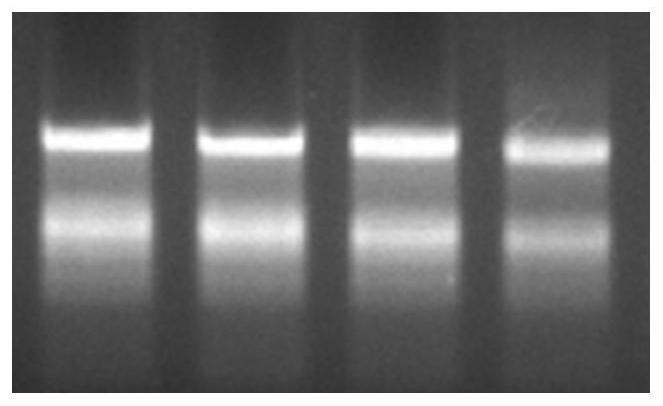Method for enhancing cold resistance of plants or cultivating high-cold-resistance plants
A kind of cold resistance and plant technology, applied in the direction of botany equipment and methods, angiosperm/flowering plants, biochemical equipment and methods, etc., to achieve the effect of reducing damage, preventing and damage, and enhancing plant cold resistance
- Summary
- Abstract
- Description
- Claims
- Application Information
AI Technical Summary
Problems solved by technology
Method used
Image
Examples
Embodiment 1
[0040] The identification of embodiment 1 dragon fruit NAC-related genes
[0041] 1. Experimental method
[0042] 1. Screening and cluster analysis of dragon fruit NAC-related genes
[0043] The NAM conserved domain model PF02365 was downloaded from the Pfam database, and all possible NAC transcription factor sequences were identified in the dragon fruit genome by using HMMER, and they were classified as HuNAC family genes. The Pfam database was integrated, and the sequences that did not contain the NAC conserved domain or the incomplete domain were removed. Finally, 64 NAC genes were identified from the dragon fruit genome database, and the first gene on chromosome 1 was named HuNAC1~HuNAC64 ( Table 1).
[0044] Download Arabidopsis thaliana (102) NAC protein sequences and dragon fruit NAC protein sequences from TAIR (https: / / www.arabidopsis.org / ) for multiple sequence alignment, and the parameters are set to default; the comparison results are performed with MEGAX software...
Embodiment 2
[0052] Example 2 Cloning of HuNAC20 and HuNAC25 New Genes
[0053] 1. Extraction of total RNA from young stems of dragon fruit and synthesis of the first strand of cDNA
[0054] 1. Experimental method
[0055] Use the EASYspin Plus Plant RNA Rapid Extraction Kit (RN53) (Aidlab, China) to extract the total RNA from the young stems of red-skinned and white-fleshed dragon fruit (refer to the manual for specific methods), and take 2 μL of RNA solution and place it on a nucleic acid analyzer to detect RNA The concentration and purity of the samples were tested by electrophoresis on 1% agarose gel, and qualified samples were used for the next experiment.
[0056] Eligible samples were reverse-transcribed from total RNA into cDNA using the PrimeScriptTM RT reagent Kit with gDNA Eraser (TaKaRa, Japan) reverse transcription kit. For specific operations, refer to the instructions. The cDNA was tested by the dragon fruit internal reference gene Actin and stored at -20°C for later use. ...
Embodiment 3
[0075] Example 3 Expression patterns of dragon fruit HuNAC20 and HuNAC25 genes at low temperature
[0076] 1. Experimental method
[0077] In order to explore the expression pattern of NAC genes in dragon fruit, this study used RT-qPCR to analyze the expression levels of HuNACs at different times under low temperature stress.
[0078] For the extraction of total RNA and the method of reverse transcription of total RNA into cDNA, refer to Example 2 of this specification. RT-qPCR primers were designed (quantitative upstream and downstream primers of HuNAC20 gene are shown in SEQ ID NO.17-18; quantitative upstream and downstream primers of HuNAC25 gene are shown in SEQ ID NO.19-20). The primer information is as follows:
[0079] SEQ ID NO. 17: GAGTATCGCCTCGCTAATGTC;
[0080] SEQ ID NO. 18: TGTTGCCCTTCTTGTTGTAGAT;
[0081] SEQ ID NO. 19: TTGGTGTTTTTATCGGAATCG;
[0082] SEQ ID NO. 20: GCATTGTTTTTCTCCCTTGTTC.
[0083] Using the cDNA of each period at a low temperature of 5°C a...
PUM
| Property | Measurement | Unit |
|---|---|---|
| molecular weight | aaaaa | aaaaa |
| molecular weight | aaaaa | aaaaa |
Abstract
Description
Claims
Application Information
 Login to View More
Login to View More - R&D
- Intellectual Property
- Life Sciences
- Materials
- Tech Scout
- Unparalleled Data Quality
- Higher Quality Content
- 60% Fewer Hallucinations
Browse by: Latest US Patents, China's latest patents, Technical Efficacy Thesaurus, Application Domain, Technology Topic, Popular Technical Reports.
© 2025 PatSnap. All rights reserved.Legal|Privacy policy|Modern Slavery Act Transparency Statement|Sitemap|About US| Contact US: help@patsnap.com



